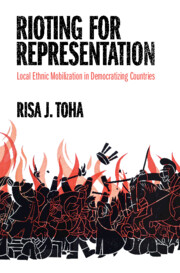Book contents
- Frontmatter
- Dedication
- Contents
- List of Figures
- List of Tables
- Acknowledgements
- 1 Introduction
- 2 Exclusion and Violence during Democratic Transitions
- 3 The Emergence of Identity-Based Cleavages in Indonesia
- 4 Ethnic Politics in Soeharto’s New Order Regime
- 5 Golkar’s Dominance and Ethnic Riots
- 6 Micro Dynamics of Exclusion and Riots
- 7 How Riots Dissipated
- 8 Conclusion
- Appendix A Data Collection Protocol
- Appendix B Additional Tables and Figures
- Glossary
- References
- Index
6 - Micro Dynamics of Exclusion and Riots
Published online by Cambridge University Press: 28 October 2021
- Frontmatter
- Dedication
- Contents
- List of Figures
- List of Tables
- Acknowledgements
- 1 Introduction
- 2 Exclusion and Violence during Democratic Transitions
- 3 The Emergence of Identity-Based Cleavages in Indonesia
- 4 Ethnic Politics in Soeharto’s New Order Regime
- 5 Golkar’s Dominance and Ethnic Riots
- 6 Micro Dynamics of Exclusion and Riots
- 7 How Riots Dissipated
- 8 Conclusion
- Appendix A Data Collection Protocol
- Appendix B Additional Tables and Figures
- Glossary
- References
- Index
Summary
This chapter discusses the specific relationships between Golkar’s entrenchment, the exclusion of local ethnic elites, and the mobilization of riots in two high-conflict Indonesian provinces, Central Sulawesi and Maluku. By comparing two pairs of districts – Ambon and Maluku Tenggara in Maluku province, and Banggai and Poso in Central Sulawesi province – I demonstrate the importance of local elites’ framing, mobilization, and organization of violence. Although the four districts are relatively similar in their religious and ethnic composition, level of economic development, and dependence on the state, Ambon and Poso experienced some of the most protracted and intense ethnocommunal violence in Indonesia’s recent history, while their two neighboring districts, Maluku Tenggara and Banggai, respectively, were relatively peaceful by comparison. Relying on interviews with bureaucrats, community leaders, and former combatants, I show that these diverging outcomes can be attributed to local elites’ initial political configuration at the onset of the democratic transition, and to their actions and responses to trigger events.
- Type
- Chapter
- Information
- Rioting for RepresentationLocal Ethnic Mobilization in Democratizing Countries, pp. 142 - 198Publisher: Cambridge University PressPrint publication year: 2021

